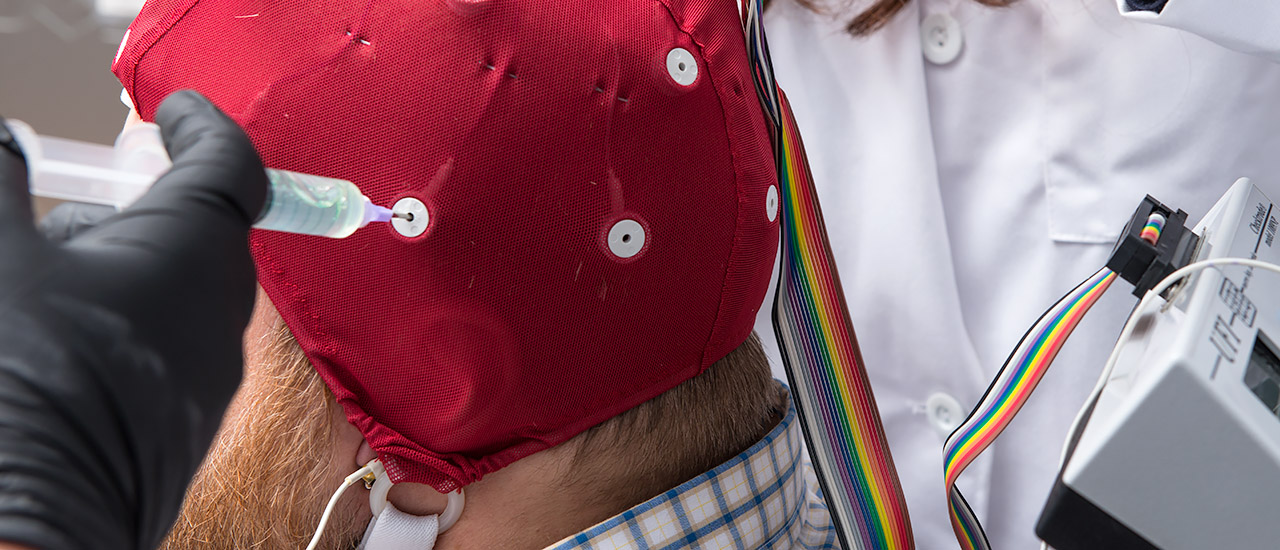
Mental Awareness
Traumatic Brain Injuries, Mental Illness And Criminal Justice System Involvement In Homeless Individuals.
Dr. Jennifer Ostergren and Dr. Robert Schug took a chance meeting and turned it into a thriving multidisciplinary lab that brings together Speech-Language Pathology, Neuro-Criminology and Clinical Psychology that aims to study the impact of traumatic brain injuries on the homeless population.
Together their work touches on how the criminal justice system, mental health diagnoses and traumatic brain injury overlap in individuals that are homeless. The CSULB Neuroscience Lab currently explores how traumatic brain injuries impact problem solving, attention and memory. Fittingly, the lab’s slogan is “Brains At The Beach!”
Schug and Ostergren, both part of the College of Health and Human Services, crossed paths when Schug was seeking equipment for a project he was starting that scanned brain activity, and Ostergren happened to have access to EEG machines for some of her work. They quickly found that their research overlapped in ways neither of them previously considered.
“I never would have thought to explore these topics in this way without our paths crossing,” Ostergren said of the partnership.
Schug originally envisioned the lab as an extension of the neurocriminology work he had been doing previously at the University of Southern California, but once the duo began collaborating, it quickly took on a life of its own.
With the support of a $9,925 National Institutes of Health (NIH) BUILD grant, the lab has earned legitimacy, and the PIs have had doors opened to other collaborative partnerships, mainly forging a valuable relationship with The Long Beach Rescue Mission.

“The Long Beach Rescue Mission has been awesome in partnering with us and realizing that this is an opportunity to learn more about the population that they serve,” Ostergren said. Homeless clients from the mission volunteer to participate in the research.
“Each volunteer spends a full day at the lab, gets paid for their time and hopefully leaves with a better understanding about themselves,” Schug said. “It is an opportunity for them to tell their amazing stories, be heard and honored as people, and to help others.”
Volunteers from The Long Beach Rescue Mission are transported to campus for a day at the lab. Once there, they complete a full battery of assessments and interviews to understand skill sets, including memory tests and tests on ability to think critically. The lab also employs EEG screenings to collect electrical information at the level of the scalp at rest while engaging in tasks that require the volunteers to think and respond in a certain way. Ostergren, Schug and their team then take the information and examine it.
“We compare what we see behaviorally to what we see in neurophysiology and overlap that on what we know about them as people,” Ostergren said.
Currently, the lab has been able to screen, on average, two participants a week. The BUILD grant will hopefully allow for more screening capacity, though Ostergren and Schug have no plans to alter the lengthy and involved interview and testing process currently in place.
“Everything that tells us about them as people, and really understand their thinking skills, is related to the model we’ve built,” Schug said.
Support from the BUILD grant doesn’t just come in the form of financial backing; BUILD students are active in all aspects of the lab. Two upper division and one lower division BUILD students assist with research and documentation. The lab plans to take on more students in the coming year.
“The work is really purposeful and personal for me. I was in a car accident and got a concussion, and now that I’m doing research on brain injuries, I feel like I can approach the work with compassion and understanding,” BUILD student Matt Argame said.
Schug has split his time between teaching and research at CSULB and the Metropolitan State Hospital forensic psychiatric unit. He says that at times, the patients he encounters exhibit many of the same characteristics as the volunteers that come to the lab.

“I would often see many of the same symptoms and the same sets of issues at the hospital as we do in the lab, but at the lab we just seem to have caught them at a different part of the timeline,” Schug said. “It really does speak to the high prevalence of mental illness among the homeless.”
Additionally, Ostergren and Schug are attempting to determine the chronology of brain injuries in homeless populations. If the brain injuries are occurring because of unstable living environments, then they extrapolate that out to disorders such as anti-social personality disorder or other mental health diagnoses that appear to have a connection to brain injuries. Getting the individual to the right services depends on knowing the individual holistically.
“Ideally, what we want to do is take that information and come up with a list of recommendations that can be utilized when a social worker interfaces with an individual who is in need of services so they aren’t afraid to ask additional questions that help to shape the type of support services an individual with a brain injury receives,” Ostergren said.
For example, shifts have started to occur in the way services are administered in the community. Previously, Ostergren and Schug said, if a person experiencing a period of homelessness was also experiencing substance abuse issues, it was expected that the individual become sober before being placed in housing. The model has now shifted to providing housing first, because it has become evident that when an individual is living on the streets it can be nearly impossible to get clean.
“If someone is coming into a situation with cognitive deficits, it helps to know that. We don’t want to set someone up for failure. This is a way we can make a more immediate difference,” Ostergren said.
Schug and Ostergren see their work continuing to overlap and hope that their work inspires more unexpected partnerships that have real impact in underserved communities.